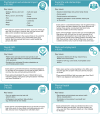Traversing Shifting Sands-the Challenges of Caring for Someone With Alzheimer's Disease and the Impact on Care Partners: Social Media Content Analysis
- PMID: 39965199
- PMCID: PMC11888061
- DOI: 10.2196/55468
Traversing Shifting Sands-the Challenges of Caring for Someone With Alzheimer's Disease and the Impact on Care Partners: Social Media Content Analysis
Abstract
Background: Social media data provide a valuable opportunity to explore the effects that Alzheimer disease (AD) has on care partners, including the aspects of providing care that have the greatest impacts on their lives and well-being and their priorities for their loved ones' treatment.
Objective: The objective of this social media review was to gain insight into the impact of caring for someone with AD, focusing particularly on impacts on psychological and emotional well-being, social functioning, daily life and ability to work, health-related quality of life, social functioning, and relationships.
Methods: We reviewed social media posts from 4 sources-YouTube (Google), Alzheimer's Association, Alzheimer Society of Canada, and Dementia UK-to gain insights into the impact of AD on care partners. English-language posts uploaded between May 2011 and May 2021 that discussed the impact of AD on care partners were included and analyzed thematically.
Results: Of the 279 posts identified, 55 posts, shared by 70 contributors (4 people living with AD and 66 care partners or family members), met the review criteria. The top 3 reported or observed impacts of AD discussed by contributors were psychological and emotional well-being (53/70, 76%), social life and relationships (37/70, 53%), and care partner overall health-related quality of life (27/70, 39%). An important theme that emerged was the emotional distress and sadness (24/70, 34%) associated with the care partners' experience of "living bereavement" or "anticipatory grief." Contributors also reported impacts on care partners' daily life (9/70, 13%) and work and employment (8/70, 11%). Care partners' emotional distress was also exacerbated by loved ones' AD-related symptoms (eg, altered behavior and memory loss). Caregiving had long-term consequences for care partners, including diminished personal well-being, family and personal sacrifices, loss of employment, and unanticipated financial burdens.
Conclusions: Insights from social media emphasized the psychological, emotional, professional, and financial impacts on individuals providing informal care for a person with AD and the need for improved care partner support. A comprehensive understanding of care partners' experiences is needed to capture the true impact of AD.
Keywords: Alzheimer disease; burden; caregiver; health-related quality of life; social media.
©Kristian Steen Frederiksen, Julie Hahn-Pedersen, Rebecca Crawford, Ross Morrison, Rose Jeppesen, Lynda Doward, Wendy Weidner. Originally published in the Journal of Medical Internet Research (https://www.jmir.org), 18.02.2025.
Conflict of interest statement
Conflicts of Interest: This study was funded under a research contract between Novo Nordisk and RTI Health Solutions and was funded by Novo Nordisk. JH-P and RJ are employees of Novo Nordisk, the sponsor of this study. RC and LD are employees of RTI Health Solutions; RM was an employee of RTI Health Solutions at the time of the study. KSF serves on an advisory board for Novo Nordisk, for which he receives no personal remuneration. WW plays an occasional advisory role for Novo Nordisk, for which she receives no personal remuneration.
Figures


References
-
- Dementia Fact Sheet World Health Organisation. 2022. [2022-10-27]. https://www.who.int/news-room/fact-sheets/detail/dementia .
-
- Gauthier S, Servaes S, Morais JA, Webster C, Rosa-Neto P. Alzheimer?s disease international. World Alzheimer Report 2022: Life after diagnosis: Navigating treatment, care and support. 2023. [2023-05-31]. https://www.alzint.org/u/World-Alzheimer-Report-2022.pdf .
-
- 2021b. What is Alzheimer?s disease? Alzheimer?s Association. [2022-06-09]. https://www.alz.org/alzheimers-dementia/what-is-alzheimers .
-
- Global estimates of informal care. Wimo A, Gauthier S. Wimo A, Gauthier S, Prince M; Alzheimer?s Disease International and Karolinska Insitutet. 2018. [2023-09-19]. https://www.alzint.org/u/global-estimates-of-informal-care.pdf .
Publication types
MeSH terms
LinkOut - more resources
Full Text Sources
Medical
Miscellaneous

